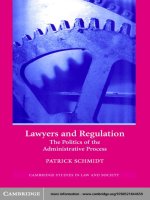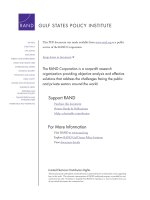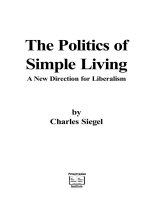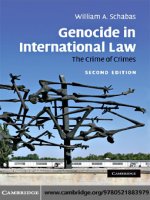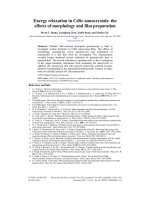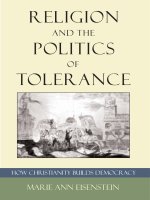Evangelical christianity in sri lanka the politics of growth
Bạn đang xem bản rút gọn của tài liệu. Xem và tải ngay bản đầy đủ của tài liệu tại đây (5.04 MB, 359 trang )
EVANGELICAL CHRISTIANITY IN SRI LANKA: THE POLITICS OF GROWTH
ORLANDO WOODS
B.A. (University College London)
A THESIS SUBMITTED FOR THE DEGREE OF
DOCTOR OF PHILOSOPHY
DEPARTMENT OF GEOGRAPHY
NATIONAL UNIVERSITY OF SINGAPORE
2012
!
i!
Acknowledgements
Many people have contributed to this research. My supervisor, Lily Kong, has
provided clear academic leadership throughout the course of the PhD, and has
propelled my academic development fast and far. My thesis committee – Robbie Goh
and Tracey Skelton – has provided encouragement, especially during the early stages
of the research. In addition, the National University of Singapore has provided an
institutional covering, financial support and access to resources, without which this
research would not have been possible.
During fieldwork in Sri Lanka, a number of people – Christian and Buddhist –
assisted me with sampling and logistics. Although these individuals shall not be
named, I am nonetheless grateful for their support. Many interviewees extended
kindness to me, through the provision of food, tea, transportation or supporting
documents. All of these people not only made the research process smoother, but
more enjoyable as well.
Finally, thanks to my partner, Samantha, for tolerating my absences – both physical
and mental – over the past three years.
!
ii!
Table of Contents
Acknowledgements
i
Table of Contents
ii
Abstract
v
List of Tables
vii
List of Figures
vii
CHAPTER 1: INTRODUCTION
1
1.1
Religion in postcolonial Asia
1
1.2
Towards a geographical understanding of religious growth
4
1.3
Research aims and thesis structure
6
CHAPTER 2: THE GROWTH OF EVANGELICAL CHRISTIANITY
IN GLOBAL AND LOCAL PERSPECTIVE
11
2.1
Introduction
11
2.2
Theorising evangelical Christian growth in modernity
12
2.2.1
Structural determinants of religious change
14
2.2.2
Existing approaches to religious economy theorisation
17
2.2.3
Problematising the structural determinants of change
19
2.2.4
Human agency and religious conversion
21
2.2.5
The evangelical organisation as an arbiter of religious change
24
2.3
Variegated patterns of evangelical Christian growth
27
2.4
Evangelical Christian growth within a spatial framework
30
2.4.1
Theorising sacred space
34
2.5
Conceptual framework
37
2.5.1
The structural mosaic as an enabler of religious growth
38
2.5.2
The spatial modalities of the structural mosaic
42
2.5.3
The house church as networked space
44
2.6
Summary
49
CHAPTER 3: METHODOLOGY AND EMPIRICAL CONTEXT
52
3.1
Introduction
52
3.2
Sri Lanka’s contested religious marketplace
53
3.2.1
Christianity, Sinhalatva, and the rise of Buddhist protectionism
in Sri Lanka
54
3.2.2
The Prohibition of Forcible Conversion Bill
57
3.2.3
Oligopoly dynamics and Sri Lanka’s informal religious
economy
60
3.3
Critical ethnography in a cross-cultural context
64
3.4
Cross-cultural research ethics
68
3.4.1
Problematising institutional ethics
70
3.4.2
Positionality, personality, performativity: a triumvirate of
researcher reflexivity
72
3.5
Methods
77
3.5.1
Sampling technique
79
!
iii!
3.5.2
In-depth interviews
82
3.5.3
Observations
88
3.6
Research sites
91
3.6.1
Colombo and the Western Province
93
3.6.2
The Southern Province
97
3.6.3
The Central Province
100
3.6.4
The Northern and Eastern Provinces
106
3.7
Summary
108
CHAPTER 4: REALISING EVANGELICAL AGENCY WITHIN A
STRUCTURALLY HOSTILE ENVIRONMENT
110
4.1
Introduction
110
4.2
Scalar determinations and dissident geopolitics
111
4.3
A relational model of Christian competitiveness
115
4.4
Overcoming boundaries: patterns of secrecy and subterfuge
117
4.4.1
The (in)visibility of evangelical Christian presence
118
4.4.2
Mobilising and deploying the laity
122
4.4.3
Strategies of spatial diffusion
127
4.5
Foreign catalysts
131
4.5.1
Relative need
133
4.5.2
The space of parallel entitlement
137
4.6
Strategic extra- and intra-group networks of influence
140
4.6.1
Extra-group networks
140
4.6.2
Intra-group networks
144
4.7
The structural mosaic in action
147
4.7.1
Using the structural mosaic as a strategy of Christian co-
optation
148
4.7.2
Using the structural mosaic to influence others
156
4.8
Summary
161
CHAPTER 5: LOCATING EVANGELICAL PRAXIS IN SRI LANKA
164
5.1
Introduction
164
5.2
Locational hierophanies
165
5.3
Spaces of evangelism
169
5.4
The urban-rural paradox
169
5.4.1
Urban nodes and the spatial diffusion of evangelicals
170
5.4.2
The supply of Christianity
173
5.4.3
The demand for Christianity
176
5.5
The public-private paradox
178
5.5.1
The public place of religion in Sri Lanka
180
5.5.2
The house as church
184
5.5.3
Evangelism in the public domain
190
5.5.4
Evangelism in the private domain
195
5.6
Spaces of youth evangelism
201
5.6.1
Proximate spaces of evangelism: the youth club
203
5.6.2
Detached spaces of evangelism: the youth camp
207
5.6.3
Non-Christian spaces of evangelism: the university campus
209
5.7
Obfuscating evangelical space using the structural mosaic
212
!
iv!
5.7.1
The Buddhist temple as a space of subordination
213
5.7.2
The house church as a space of subversion
217
5.8
Summary
221
CHAPTER 6: THE POLITICS OF EVANGELICAL CHRISTIAN
GROWTH
223
6.1
Introduction
223
6.2
Place-bound politics of growth
224
6.2.1
Spatial buffering as a strategy of resistance
226
6.2.2
The politics of permission
233
6.3
Converting houses into churches
236
6.3.1
The politics of place(lessness) and church fission
237
6.3.2
The volatility of sacred networks
243
6.3.3
House churches and religious dualism
245
6.4
Converting people
250
6.4.1
The market mentality
252
6.4.2
Negotiating public and private spaces of evangelism
254
6.4.3
Unethical conversion and the structural mosaic
260
6.5
Debating “unethical” conversion
267
6.6
Summary
272
CHAPTER 7: BUDDHIST HEGEMONY IN A GLOBAL SCHEMA
274
7.1
Introduction
274
7.2
The destabilisation of primordial power structures
276
7.3
Constructing the Christian “threat”
278
7.3.1
Christianity as a symptom of the (neo-) colonial “West”
279
7.3.2
Connecting Christianity and the NGO conspiracy
282
7.3.3
Buddhist insecurity in global perspective
285
7.4
Buddhist protectionism and hegemony
289
7.4.1
The discursive formations of self-Orientalism
289
7.4.2
Cultural intransigence and religious (im)mobility
294
7.4.3
The violent outcomes of Buddhist hegemony
300
7.5
Summary
306
CHAPTER 8: CONCLUSIONS
308
8.1
Chapter summaries
308
8.2
Key contributions and relevance for future research
314
8.2.1
A spatial understanding of evangelical Christian growth
316
8.2.2
Network-based sacred space
317
8.2.3
Towards a more extrospective geography of religion
319
8.3
Autocritique and final comments
320
BIBLIOGRAPHY
323
APPENDIX 1: The Prohibition of Forcible Conversion Bill
345
APPENDIX 2: Interview Schedule
350
!
v!
Abstract
This thesis develops a new understanding of evangelical Christian growth in the
contemporary world. Existing explanations of growth are well rehearsed within the
social sciences, and draw clear distinctions between the characteristics of evangelical
organisations, and the structural contexts in which they operate. Notwithstanding, a
number of theoretical and empirical assumptions render such explanations applicable
in some countries, but not others. Drawing on qualitative data collected in Buddhist-
majority Sri Lanka throughout 2010-11, I argue that closer examination of the
recursive relationship between organisation (agency) and context (structure) will lead
to recognition of the fact that growth is a spatially defined process, with evangelical
organisations being tied to localities in complex and multifarious ways. Four
empirical chapters develop this argument further. The first examines how, in
structurally hostile environments, evangelical groups grow in ways that are more
relational than otherwise recognised, and become adept at spreading their evangelical
influence through the appropriation and use of non-religious spaces. The second
focuses on the spatial variability of evangelical praxis, showing how it varies between
urban and rural, and public and private spaces and, more specifically, how strategic
engagement in and through space is a defining feature of youth evangelism. The third
critically draws upon the findings of the first two chapters by exploring the politics of
evangelical Christian growth – specifically the politics of the house church, and the
allegations of “unethical” activity that foreground the politics of converting both
people, and space. The fourth empirical chapter explores how Buddhist hegemony
develops as a response to evangelical Christian growth, and how Buddhist insecurity
in the face of Christian globalism can translate into extreme forms of religious
!
vi!
protectionism and violence. To conclude, I show how the findings not only contribute
to the continued evolution of the geographies of religion, but also highlight the value
of a more extrospective sub-discipline that engages with, challenges and develops
more wide-ranging debates that exist outside our putative disciplinary boundaries.
!
vii!
List of Tables
Table 1
Sri Lanka’s mainline and evangelical Christian denominations by
representative body
62
Table 2
Interview sample by location (province/district) and organisation
type
87
List of Figures
Figure 1
Map showing the territorial delineations of the 10/40 Window
29
Figure 2
Map showing field sites at the district level in Sri Lanka
93
Figure 3
Inside the People’s Church, Colombo
95
Figure 4
The external façade of the Calvary Church, Colombo
96
Figure 5
A sign of Buddhist religiosity in Galle?
99
Figure 6
Kandy – “the Vatican of Buddhism” – at dusk
102
Figure 7
An estate line in Nuwara Eliya
104
Figure 8
Inside the estate lines
105
Figure 9
(Re)building Hinduism in Trincomalee
107
Figure 10
Growing the church by asking the laity to “Harvest 12”
125
Figure 11
An evangelical church in Nuwara Eliya, built using funds raised
in Singapore
136
Figure 12
Providing toilets for an estate line in Nuwara Eliya
146
Figure 13
A clean water source in Hambantota district
151
Figure 14
A Christian NGO in Vavuniya receiving a consignment of bibles
158
Figure 15
Proclaiming a Christian message in an urban setting
176
Figure 16
The Dutch Reformed Church in Galle Fort
181
Figure 17
A mobile pastor in Nuwara Eliya
187
Figure 18
The handbag of an evangelical pastor’s wife in Trincomalee
192
Figure 19
A house church service in an estate line in Nuwara Eliya
202
Figure 20
A fully-grown Bo tree and adjoining Buddhist shrine, Colombo
229
Figure 21
Spatial crowding in a Colombo suburb
231
Figure 22
Hindu shrine located in the line room of a recently converted
“Christian” family
247
Figure 23
Disadvantaged children queue up for a free lunch at a feeding
centre in a north Colombo suburb
263
Figure 24
The United Nations headquarters in Colombo under siege
283
Figure 25
Military personnel in front of a Buddhist statue, Colombo
303
N.B. Figures 2-25 are the author’s own.
!
1!
CHAPTER 1: INTRODUCTION
1.1 Religion in postcolonial Asia
Evangelical Christianity is one of the fastest growing and most widely dispersed
religious groups in the world today. The evangelical remit, pursued to varying degrees
by all Christian groups, is a biblical mandate
1
, yet the processes of evangelisation that
lead to growth are fraught with politics that are under-researched, and often
misunderstood. This thesis fills the lacuna by exploring the politics of evangelical
Christian growth. It focuses specifically on how evangelism catalyses inter- (and
intra-) religious competition for resources, such as ‘people, territory, wealth, positions
of power, and economic advantage… dignity, prestige, and all manner of symbolic
capita’ (Lincoln 2003: 74), and how religious conflict is often a by-product of the
competitive desire to ‘overcome, eliminate, or convert the other to extinction’ (Bouma
2007: 190). In doing so the thesis adopts a systemic approach to understanding
Christian growth; one that positions evangelical groups not as autonomous agents, but
as situated stakeholders that are both sensitive, and responsive to the structural
conditions of a locality. I do this using a detailed analysis of the religious context of
Sri Lanka, where I also explore how religious competition can legitimate the political
aspirations of anti-Christian religious groups, and can lead to a number of paradoxical
outcomes that contribute to, whilst simultaneously compromise, Christian growth.
Such a dynamic is not unique to Sri Lanka, but is particularly pronounced in
postcolonial Asia, where growth often reveals an irreconcilable tension between the
!!!!!!!!!!!!!!!!!!!!!!!!!!!!!!!!!!!!!!!!!!!!!!!!!!!!!!!!
1
In particular, the Great Commission is the instruction of the resurrected Jesus Christ to his disciples,
telling them to ‘go and make disciples of all nations, baptising them in the name of the Father and of
the Son and of the Holy Spirit’ (Matthew 28: 19).
!
2!
globalist ambitions of evangelical Christianity, and the localist ambitions of
primordial, non-Christian religious groups. In Malaysia, for example, police recently
sanctioned a mass gathering of Muslims in the capital city, Kuala Lumpur, seeking to
‘defend Islam against Christian proselytisation’ (The Straits Times 20.10.2011). The
so-called ‘anti-proselytisation rally’ had been organised to bolster proposals put forth
by a confederacy of Muslim organisations for a new law to punish those who try to
convert Muslims. This example reflects similar anti-conversion legislation proposed
(and implemented) in Bhutan, India
2
and Sri Lanka, and contributes to an emerging
trend amongst postcolonial nation-states seeking to defend their religious sovereignty
against the destabilising threat of unchecked Christian proselytism. Strategies of
“religious protectionism” (see Robbins 2004) typically involve the strengthening of
dominant religious groups along nationalist and/or ethnic lines, as ‘the cause of
“nationalism” has [often]… turned a religiously plural society into one defined by
religious hegemony’ (Ammerman 2010: 164). This contributes to a dual occurrence
of hegemony: the aspirations of Christian globalism and the assertions of religious
nationalism, both of which have a role to play in catalysing competition and conflict.
In Sri Lanka, more specifically, recent decades have witnessed the emergence of a
Buddhist political elite; one that is intolerant to difference, chauvinistic, and seeks to
contain the spread and influence of evangelical groups via increasingly punitive
means. In 2005 newly elected Prime Minister Mahinda Rajapakse remarked that ‘the
religious unrest currently felt in Sri Lanka is even more serious than racial or ethnic
unrest’ (cited in Matthews 2007: 456); sentiment that is amplified by the decades-long
!!!!!!!!!!!!!!!!!!!!!!!!!!!!!!!!!!!!!!!!!!!!!!!!!!!!!!!!
2
In India, anti-conversion legislation (ironically entitled the “Freedom of Religion Act”) has been
implemented in the states of Orissa, Madhya Pradesh, Chhattisgarh, Himachal Pradesh, Tamil Nadu
and Gujarat. In Arunachal Pradesh and Rajasthan, similar laws have been passed, but await
implementation.
!
3!
civil war being fought at the time. Influenced by the colonial legacy of Christian
administrations, education systems, buildings and missionaries, Buddhist groups have
long sought to (re)establish their religious primacy. A growing Christian presence
since the 1980s has galvanised anti-Christian rhetoric and action from the Buddhist
right. Containment strategies range from informal acts of violence to more formal
processes of structural resistance that serve to restrict the actions and autonomy of
Christian groups. Indeed, the ontological incongruence between Buddhism and
violence has only recently been labelled a ‘misconception’ (Jerryson 2010: 3),
presenting a relationship that is worthy of closer interrogation (see Jerryson and
Juergensmeyer 2010; in particular, Kent 2010). Given that academic studies have
‘rarely cited [Buddhism] as a political force’ (Jenkins 2007: 217), the politics of
evangelical growth in a Buddhist context is an understudied problem that, for a
variety of reasons, commands attention.
The moral impetus for this thesis is my belief in the freedom of religious choice. As
an atheist, I feel that religious belief should be guided by individual volition, and that
religious choice is something that should not be forced or denied. In the Sri Lankan
context, such volition is challenged by allegations of “unethical” conversion to
Christianity on the one hand, and the difficulty of converting out of Buddhism on the
other. Such allegations and difficulties fuel the politics of evangelical Christian
growth in Sri Lanka and are, to a large extent, a function of the idiosyncrasies of the
“geo-religious” context within which they occur (see Allievo and Dassetto 1999).
Throughout postcolonial Asia, centuries of Christian missionisation and conversion
have led to the creation of “geo-religious” spaces that are highly sensitive to
contemporary conversion, and can easily trigger residual feelings of colonial
!
4!
resentment and domestic insecurity. As Agnew (2006: 185) recognises, the fact that
‘much nationalism and imperialism have found purpose and justification in religious
differences and in proselytising’ affirms the reality that discourses of contemporary
Christian growth are not just a matter of religious concern, but engage with other,
assumedly “non-religious” issues as well. Attempts to better situate Christian growth
in different religious, socio-cultural and political contexts around the world will see
discourse engage with the challenges posed by the groups involved, which more often
than not prefer to be in a position of religious control than a part of the compromising
jigsaw of religious pluralism.
1.2 Towards a geographical understanding of religious growth
The geographies of religion have been described as a ‘burgeoning subfield’ (Wilford
2009: 328) within human geography, yet there is a continual need to realise their
wide(r)-ranging potential by pushing the boundaries of how they can engage with
other subfields from within, and without, the discipline. The value of studying
religious growth is that it is often a symptom of underlying, and more broad-based
political, economic, social and cultural processes within which geographers, and
geography, are centrally implicated. Existing explanations of growth originating from
the broader social sciences do not, for example, account for how Christian groups are
able grow in hostile environments like that of Sri Lanka. This is partly due to a lack of
clarity and nuance when defining what actually constitutes “religious growth”. In
places like Sri Lanka, religious growth is reflected in many different ways, some of
which are more easily quantified than others. I posit that an understanding of growth
should be multivalent, and cover not just tangible/numerical indicators, such as
!
5!
conversions and the planting of churches, but also more intangible markers, such as
public debates surrounding Christianity, and growing awareness of Christian actions
in the public conscience. The privileging of the quantifiable over the unquantifiable
has caused discourse to focus on numerical increases in Christian populations rather
than the discursive effects of a strengthening religious cohort. Whilst the former is
undeniably important, it is self-restricting and lacks universal application.
The thesis also reflects a growing trend amongst geographers seeking to carve out
their own niche in the social scientific study of religion by ‘bring[ing] forward
approaches that will enable us to engage in larger, related debates that are animating
other disciplines’ (Brace et al., 2006: 29). In light of this, Kong’s (2010: 763) recent
call for geographers to ‘go beyond insightful analyses of the micropolitics of religious
spatial expressions to contribute to an understanding of larger social and political
events confronting the contemporary world, including religious conflict and religious
change’ provides the impetus for the thesis, not least because the processes of
Christian growth – notably evangelisation and proselytisation – drive change and
conflict, and can influence perceptions of, and behaviours towards other religions at
both the micro- and macro-scales. In addition, such processes are often a symptom,
and function of the public resurgence of religion, with religion having become as
much a matter of public expression as it is private belief (see Habermas 2006). Such
resurgence reifies the latent, yet under-appreciated role of religion in matters of
geographical enquiry, and underwrites the continual need to realise a more “relevant”
geography of religion sub-discipline (see Pacione 1999; Henkel 2005; Brace et al.
2006; Kong 2010).
!
6!
1.3 Research aims and thesis structure
By taking steps towards realising a more “relevant” geography of religion, the
overarching aim of the research is to develop an understanding of evangelical
Christian growth that goes beyond the confines of putative disciplinary boundaries. In
doing so I integrate sociological theorisations with geographical perspectives in a
mutually enriching way. To this end, the first aim is to identify and explain
organisational strategies of evangelism – how Christian groups engage with and
influence society and, in turn, how such strategies of engagement are influenced by
the structural conditions of a locality. Ancillary to this is a detailed exploration of the
spaces through which Christian growth is enacted, which results in a recurrent focus
on the formation and disbandment of the Sri Lankan house church. A second aim is to
develop a clearer understanding of the types, motivations and outcomes of Buddhist
resistance to evangelical Christian growth. I examine not just the physical persecution
of Christians by Buddhists, but explore more symbolic (e.g. spatial) forms of
resistance as well. The third aim is to evaluate the relative success (and often
unexpected outcomes) of Christian growth and Buddhist resistance, which in turn will
contribute to a more nuanced understanding of religious growth. The rationale for,
and application of these aims is expounded in the chapter summaries that follow.
Chapter 2, the literature review and conceptual framework, seeks to integrate existing
approaches to theorising evangelical Christian growth with new opportunities that
emerge when such approaches are critiqued through the lens of geographical
understanding. More specifically, I argue that existing approaches have developed
from an understanding of Christian growth in places in which it is most pronounced,
!
7!
and hold little relevance when applied to a large swathe of territory that covers much
of Asia (including Sri Lanka), the Middle East and Northern Africa, and is
collectively referred to as the 10/40 Window (see page 29). By articulating the need
for theory to begin recognising, exploring and developing the recursive relationship
between structure and agency within such contexts, I argue that the structural mosaic
– a heuristic device that recognises the heterogeneity of structure – can generate a
clearer understanding of Christian growth in hostile environments. By recognising the
heterogeneity of structure, the structural mosaic sensitises discourse to how religious
agents can infiltrate (seemingly hostile) religious structures via non-religious
structural influencing. I also focus on the important role of space in mediating and
determining strategies of evangelical Christian growth, and explore in detail the use of
the house church as both articulation of the structural mosaic in practice, and one of
the most globally pervasive, yet often undetected locations of evangelical activity.
Chapter 3 outlines the empirical context and methodology, and starts with a
description of Sri Lanka’s religious marketplace. The discussion is couched in
religious economy parlance (first introduced in Chapter 2), and shows how the case of
Sri Lanka requires new understandings of the workings of an “oligopolistic” religious
marketplace. Guided by my multivalent understanding of religious growth, in the
second part of the chapter I highlight the need for more qualitative understandings of
religious change – something that presents a significant departure from the existing,
quantitative methodologies that currently dominate. A critical ethnographic approach
is outlined, and the sampling strategies and methods of data collection discussed.
Finally, I introduce the research sites in order to capture the contextual determinants
!
8!
of evangelism at the micro-scale, and to account for locational nuances in data
collection around the country.
Chapter 4 is the first empirical chapter, and provides an overarching backdrop for the
subsequent three chapters. It attempts to explain how evangelical Christian groups
remain competitive and grow, despite being subjected to various forms of structural
resistance in Sri Lanka. I argue that such groups compete in ways that are more
relational than otherwise thought (or recognised), and in doing so they remain largely
innocuous to surveillance by anti-Christian groups. Specifically, I explore how the
actions of evangelical groups reflect patterns of secrecy and subterfuge that enable
them to overcome boundaries and barriers to growth, and how foreign catalysts and
the development of strategic extra- and intra-group networks of influence help
stimulate growth. I also apply my concept of the structural mosaic, using empirical
examples to show how Christian groups often conflate secular practices (termed
“social ministries”, such as Montessori’s, relief provision and long-term development
programmes) with their evangelical objectives in order to co-opt or influence others.
Chapter 5 explores the locations and determinants of evangelical praxis in Sri Lanka.
Through a focus on two dichotomous pairings – urban-rural and public-private –
Chapter 5 starts by examining some of the locational paradoxes that are an inherent
part of evangelical praxis in Sri Lanka. Specifically, I explain why, in urban areas, the
supply of Christianity outstrips demand, yet in rural areas the situation is reversed
(demand outstrips supply). I also explain why the privatised nature of evangelical
praxis provokes suspicion, even while evangelical groups are marginalised from the
public domain. Following that, I focus on three spaces of youth evangelism – the
!
9!
youth club, the youth camp and the university campus – that represent some of the
most contested sites of evangelical activity. Finally, I explore the spatial modalities of
the structural mosaic, with a particular focus on how the structural mosaic enables the
obfuscation of evangelical space and, as a result, contributes to an understanding of
the (often aggressive) expansion of evangelical groups in and through different
spaces.
Chapter 6 is divided into three sections, each of which focuses on a different facet of
the politics of evangelical Christian growth. The first section examines the place-
bound politics of growth that prevents many evangelical groups from establishing a
formal religious presence. I examine how spatial buffering – through the use of Bodhi
(“Bo”) trees and Buddhist statues – is used to contain Christian expansion, and how
the politics of permission prevents many evangelical groups from registering churches
and operating more within the public domain. In the second section I examine the
politics of converting space, with particular reference to the house church. More
specifically, because the house church is essentially a space of subversion, I argue that
it is replete with politics that encourage church fission and dualistic religious
behaviours amongst congregations. In the third section I examine the politics of
converting people, with particular reference to the market mentality of evangelicals,
the spatial modalities (with particular regard to the public-private paradox, previously
discussed in Chapter 5) of the “unethical” conversion debate, and the value of the
structural mosaic in helping to contribute new perspectives to the debate. The chapter
ends with an exploration of what “unethical” conversion means to the Christian
groups implicated in the discourse, the aim being to expand the frame of debate
beyond the parameters defined by Sri Lanka’s Buddhist right.
!
10!
Chapter 7 is the final empirical chapter, and explores how evangelical Christianity
contributes to the development of, and provides justification for Buddhist hegemony
in Sri Lanka. I show how evangelism destabilises primordial power structures and
how such destabilisation warrants the construction of a Christian “threat” by right-
wing Buddhist groups. Constructing the Christian “threat” involves implicating
Christian groups in broader allegations of Western imperialism that are perpetrated by
churches and non-governmental organisations (NGOs), which in turn reveals the
compromising effect of globalisation on the Buddhist right. The chapter ends by
exploring the linkages between Buddhist protectionism and hegemony. I argue that
strategies of protection are often based on a self-Orientalising assumption of
vulnerability, which serves to restrict the religious mobility and freedom of the
Buddhist masses, and contributes to a number of violent outcomes perpetrated against
the Buddhist self, and Christian other. I conclude by highlighting the key
contributions and limitations of the thesis, and the possibilities that present
themselves for further research.
!
11!
CHAPTER 2: THE GROWTH OF EVANGELICAL CHRISTIANITY IN
GLOBAL AND LOCAL PERSPECTIVE
2.1 Introduction
Over two decades have passed since Poloma and Pendleton’s (1989) criticism of the
lack of research explaining the explosive growth of evangelical Christian groups in
modernity; a phenomenon that is widely recognised as being ‘one of the most
important religious developments globally of our time’ (Freston 1991: 4). Subsequent
years have witnessed notable advances in identifying and explaining these
developments (e.g. Martin 1990, 2002; Hefner 1993; Cox 1996; Hollenweger 1997;
Jenkins 2007), yet important areas are left wanting. The fact remains that growth is
not consistent throughout the world, with large territories apparently untempered by
the proselytising activity of evangelical groups. Limited Christian growth throughout
North Africa, the Middle East, and much of Asia highlights the blinkered nature of
existing explanations, which is compounded by the fact that ‘Northerners rarely give
the South anything like the attention it deserves, but when they do notice it, they tend
to project onto it their own familiar realities and desires’ (Jenkins 2007: 15). Such
projections have paralysed discourse, preventing critical interrogation of the caveats
and differences that problematise and dilute existing theorisations. Moreover,
geographical perspectives are currently lacking, despite being able to contribute much
to the development of new theoretical approaches and more robust understandings of
evangelical Christian growth around the world. Through an empirical focus on the
restricted religious marketplace of Sri Lanka, I suggest how such new approaches and
understandings can develop.
!
12!
This chapter begins with an overview of existing theoretical approaches to evangelical
Christian growth. I start by examining both the structural determinants of religious
change, and human agency perspectives on religious conversion, focussing
specifically on religious economy theorisations and the organisation as an arbiter of
change. I go on to explore the variegated patterns of evangelical Christian growth
around the world, before introducing the possibilities that arise from using a spatial
framework to study religious growth and change, giving close consideration to
existing approaches to theorising sacred space in particular. Finally, I introduce the
conceptual framework, which is used to guide the four empirical chapters that follow.
I first emphasise the role of the structural mosaic as an enabler of religious growth,
with particular regard to the spatial modalities of the structural mosaic. I go on to
discuss how the house church is a spatial modality of evangelical presence and growth
that is both common throughout the world, and a cogent example of networked space.
2.2 Theorising evangelical Christian growth in modernity
Recent decades have witnessed a dramatic shift in the character and growth of
Christianity. Increasingly associated with the Southern, rather than Northern
Hemisphere, revivalism has seen large mainline denominations decline, smaller, more
independent churches grow, and ecstatic forms of worship replace their more
routinised, liturgical counterparts (Freston 2001; Jenkins 2007; Miller and Yamamori
2007). Such shifts are commonly, but not exclusively, associated with
!
13!
Pentecostalism
3
. Identified as the third wave of Protestant cultural revolution
(superseding Puritanism and Methodism), there are an estimated 500 million
Pentecostals worldwide, registering a 700 percent increase since the early 1980s
(Anderson et al. 2010). The rapidity of such growth and spread is ‘unprecedented in
the history of religions’ (Anderson 2005a: 1), having reconfigured the religious
topographies of much of Africa, Latin America, and some parts of Asia (Martin 1990;
Stoll 1990; Chesnut 2003; Heuser 2009). Moreover, the relative recency of such
reconfigurations underscores the fact that evangelical growth is often a function of
large-scale conversion to Christianity (Freston 2001, 2009), rather than more organic
demographic changes, and has accordingly been described as one of the greatest
“success” stories in the current era of cultural globalisation (Robbins 2004; Anderson
and Tang 2005). Attempts have been made to explain how and why growth occurs,
and are often based on empirical examination of the territories in which it is most
pronounced.
Below I explore existing attempts to understand religious change, with a particular
focus on evangelical Christian growth. Such attempts typically reflect Durkheim’s
(1938) dualistic approach to the study of institutions by expounding either the
structural conditions that facilitate conversion to Christianity, or the agency of
evangelical organisations and Christian converts. I explore the macro-scale, structural
determinants of religious change first (with a particular focus on religious economy
theorisations), followed by the micro-scale human agency approaches to
understanding religious conversion (often a key driver of evangelical growth). I end
!!!!!!!!!!!!!!!!!!!!!!!!!!!!!!!!!!!!!!!!!!!!!!!!!!!!!!!!
3
Throughout the thesis, the term “evangelical Christian” refers primarily to Pentecostal groups that
follow a doctrine of evangelism. Other, more historically entrenched, Christian denominations –
Anglican, Baptist, Methodist, and Presbyterian for example – are an important, but secondary concern,
given that they are typically less independent, and evangelically aggressive, than their Pentecostal
counterparts. See Table 1 for clarification in the Sri Lankan context.
!
14!
the section by examining the evangelical organisation as an arbiter of religious
change, a critique of which problematises the prevalent treatment of structure and
agency in binary terms, and leads into the subsequent section that explores the
variegated patterns of evangelical Christian growth around the world.
2.2.1 Structural determinants of religious change
Macro-scale approaches emphasise the structural factors that facilitate conversion to
Christianity, and that are common amongst places of strong Christian growth. For
more than a century, modernisation – which according to Weber (1956) equates to the
rationalisation of society – has been seen as the key structural driver of conversion
(see Hefner 1993; van der Veer 1996a; Jenkins, 2007). Conversion as a result of
modernisation is based on two premises: that the advancement of society involves a
continual reorientation towards more rational thought and action; and that a key
distinction between world religions (e.g. Christianity, Buddhism, Islam) and their
traditional counterparts (e.g. animism, ancestral worship) is the superior
rationalisation of the former
4
. Asad (1996: 263, original emphasis) provides a relevant
metaphor to explain the process of modernisation and, in doing so, evokes the
structural transition of society from traditional to world religion:
Most individuals enter modernity rather as converts enter a new religion – as a
consequence of forces beyond their control. Modernity, like the convert’s
religion, defines new choices; it is rarely the result of an entirely “free choice”.
!!!!!!!!!!!!!!!!!!!!!!!!!!!!!!!!!!!!!!!!!!!!!!!!!!!!!!!!
4
Although it should also be noted that processes of rationalisation also instigate conversion between
world religions.
!
!
15!
And like the convert’s religion, it annihilates old possibilities and puts others
in their place.
Over time the mundane instrumentalism of traditional religion (Asad’s “old
possibilities” e.g. conforming to social conventions, superstition) is replaced by world
religion (the “new choices”). Replacement occurs as rationalisation involves
searching for answers to the ethical, emotional and intellectual challenges of everyday
life – a need that is met by world religions’ proclamation of ‘the existence of a
transcendental realm vastly superior to that of everyday reality’ (Hefner, 1993: 8).
Indeed Christianity has, in many instances, proven to be relatively more successful
than its counterparts in attracting new converts. Tong (2007: 4), for example, argues
that Singapore’s science-oriented education system and associated
“intellectualization” of the population has facilitated a growing number of
conversions to Christianity. Moving away from traditional Chinese ritual practices
towards the more “rational” bible teachings of Christianity reflects a shift ‘from an
unthinking and passive acceptance of religion’ to a religion that is believed to be more
‘systematic, logical, and relevant’. Changes in the structure of society, perhaps
unknown to converts themselves, therefore play a key role in determining religious
choice.
Alternative theories point to the consequences of modernisation in initiating processes
of religious conversion. As economies develop, traditional values, lifestyles, and
systems of support become increasingly redundant. Large-scale urbanisation causes
individuals to undergo physical dislocation, to experience anomie, and to respond by
embracing new religious alternatives. Conversion has therefore been theorised as a
!
16!
neo-Marxist response to social or economic deprivation (often termed “relative
deprivation” – see D’Epinay, 1969; Marshall, 1991; Parker, 1996; Jenkins, 2007),
social disorganisation (Talmon, 1962), psychological vulnerability (Alland 1961), or
changing socio-cultural contexts (Yang, 1997; Chen, 2002; Smilde, 2007). The
relative deprivation thesis, for example, suggests that processes of modernisation
create situations of socio-economic deprivation and anomie that foster the growth of
small, independent religious groups that are adept at meeting the felt needs of a
population. This has commonly been used to explain the phenomenal growth of
evangelical and charismatic forms of Christianity throughout Latin America and
Africa in the latter half of the twentieth century (e.g. Martin, 1990, 2002; Chesnut,
1997, 2003). In Latin America, Protestant churches appeal to migrants and the
marginalised, especially those found in the region’s sprawling megacities; whereas in
Africa, Pentecostal churches are strongest where ‘neoliberal forces have eroded the
capacity of liberal democratic states to provide education, health, and welfare’
(Comaroff and Comaroff, 2003: 121). Being able to provide welfare and support, such
churches have managed to establish a foothold from which conversion takes place,
and religious alternatives flourish.
Religious economy theorisations offer a more systemic approach to understanding the
structural determinants of religious change. Central to such theorisations is the role of
regulatory structures (e.g. legislation designed to restrict or enforce pluralism, local
religious hierarchies, religio-cultural norms) in determining the growth and decline of
religious groups. Thus whilst processes of modernisation create the conditions that
facilitate conversion to Christianity (demand-side), religious economy perspectives
emphasise the role of religious organisations in competing against each other to
!
17!
attract converts (supply-side). Such perspectives are invaluable as they help sensitise
discourses of religious change to the fact that structure can both enable, and restrict,
religious growth.
2.2.2 Existing approaches to religious economy theorisation
Situated within the sociology of religion (see Warner 1993), religious economy
perspectives offer another explanation for religious conversion other than the
demand-side bias of the modernisation and relative deprivation theses. Religious
economy perspectives emphasise the role of religious groups as indicators of religious
vitality: vigorous religious groups are more competitive than their counterparts,
attracting new converts and stronger commitment from existing believers. Locating
such groups within inter-related systems of competition among religious groups and
control by regulators, religious economy theorists argue that the (in)efficacy of supply
drives religious growth or decline, which is determined by the degree to which an
economy is regulated, and competition allowed to flourish (Stark 1985; Stark and
Iannaccone 1993; Stark and Finke 2000; Chesnut 2003). Structural processes of
regulation and deregulation play fundamental roles in determining market dynamics,
as proven by the surge in religious activity in North America in the eighteenth and
nineteenth centuries following the deregulation of religion brought about by the First
Amendment (Stark and Bainbridge 1985; Finke and Stark 1992). Existing
understandings of religious economy therefore draw a clear distinction between
deregulated and regulated religious marketplaces, suggesting that the former allows
more room for inter-religious competition than the latter. Put differently, a religious


